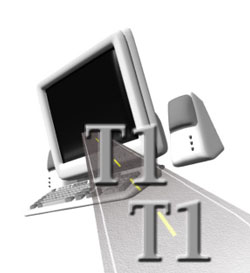By: John Shepler
While T1 lines were the preferred connectivity choice during the early days of the internet and business migration to the Web, they have since been surpassed by business cable broadband and fiber, offering significantly higher bandwidth and lower costs per Mbps. However, T1 lines remain a suitable option for certain locations and applications. The question is, can you still find them?
Introduced by the Bell system in 1962, the T1 standard is deeply rooted in phone systems, particularly for small and medium-sized businesses. Initially, T1 phone lines replaced 24 twisted pair copper analog lines with two pairs using a digital protocol. Later, ISDN PRI utilized the same T1 line to carry 23 phone conversations along with switching data and caller ID.
The adoption of T1 and its higher bandwidth counterpart, T3, by long-distance carriers effectively eliminated noise and crosstalk. Digital technology, in addition to using fewer circuits, significantly enhanced conversation quality.
T1 lines are commonly found in businesses with multiple outside lines. As the number of lines increases, so does the justification for using a digital T1 or ISDN line. Typically, digital connections become more cost-effective than analog connections with six to twelve lines. Many key telephone and PBX systems either directly support T1 or can be easily interfaced.
Rock Solid Performance and Reliability
T1 lines are dedicated point-to-point connections consisting of a pair or two of wires directly connecting your location to a telco equipment office. Service can be obtained directly from the local telephone company or through a competitive provider leasing lines and equipment from the telco.
Both T1 and ISDN PRI allocate bandwidth into channels – 24 for T1 and 23 for ISDN, with the remaining bandwidth in ISDN used for switching, ringing, and caller ID. Unused channels remain idle, ready for calls. Unlike broadband services, T1 bandwidth is not shared, making it dedicated and symmetrical, with equal bandwidth in both directions.
Another notable characteristic of T1 lines is their synchronized operation at both ends using PCM (pulse code modulation) for analog-to-digital conversion. Compared to packet-based IP networks, this synchronization ensures minimal latency, limited to equipment delay and distance. T1 lines avoid the variable latency, packet issues, dropouts, and distortion often associated with VoIP calls, making them ideal for clear and reliable phone calls and credit card verification.
T1 Broadband…It’s a Thing
While the notion of a 1.5 Mbps line being considered broadband might seem amusing today, it can be a lifeline in areas with limited connectivity options. Rural areas often lack cell service, cable, and fiber, leaving T1 lines as the only viable option. T1’s design allows it to operate on existing phone lines with regeneration equipment placed every mile.
For businesses in these areas, T1 lines can serve as a “last mile” connection to the internet. While not suitable for high-bandwidth activities like streaming 4K movies, T1 can support essential business functions like inventory management and software applications. Bonding multiple T1 lines can provide higher bandwidth (up to 10-12 Mbps), though this comes at a cost and might not be universally available.
A Faster Alternative
Ethernet over Copper (EoC) is a newer protocol that utilizes the same twisted pair cabling as T1 but operates at significantly higher speeds. However, EoC’s effectiveness diminishes with distance from the equipment office. Within a mile or two, speeds of 10-20 Mbps are achievable, but beyond that, T1 remains more reliable. EoC is a worthy consideration for businesses located outside city limits without access to fiber or cable, offering attractive pricing and potentially sufficient bandwidth.
If your phone system requires a stable connection or you’re facing connectivity challenges, exploring T1 and related technologies is advisable. Several carriers still offer T1 services. Request a quote for a T1 line to see if it meets your requirements.


